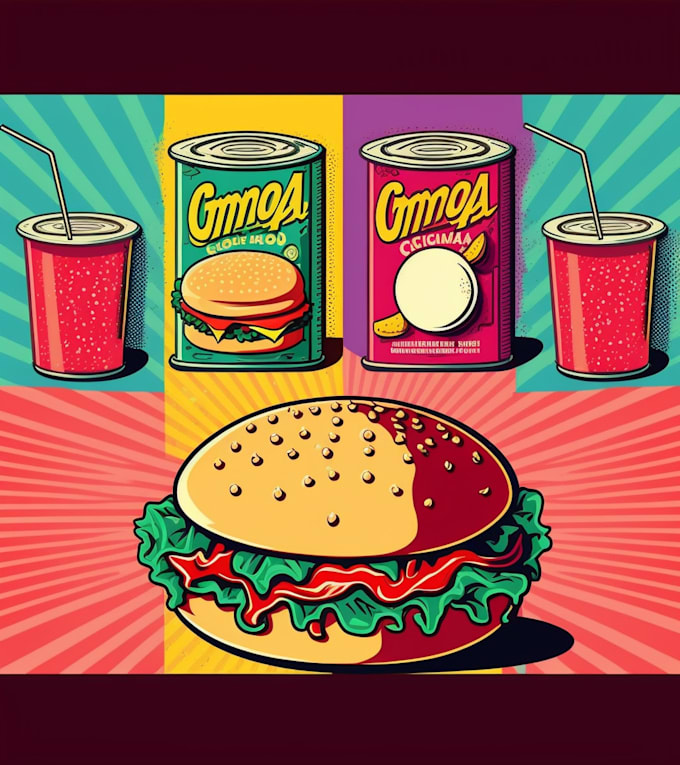The vibrant world of Pop Art food - a realm where culinary delights meet artistic expression, and the ordinary becomes extraordinary. This fascinating intersection of food, art, and culture has given rise to a unique aesthetic that celebrates the bold, the colorful, and the playful. From iconic snacks to decadent desserts, Pop Art food has redefined the way we experience and interact with the things we eat.
In the 1950s and 60s, the Pop Art movement, led by pioneers like Andy Warhol and Roy Lichtenstein, challenged traditional notions of art by embracing popular culture and consumerism. Food, as a universal language, became an integral part of this movement, with artists using everyday edible items as subjects for their work. The result was a visual language that was both accessible and thought-provoking, blurring the lines between high art and mass culture.
One of the most recognizable examples of Pop Art food is the Campbell’s Soup Can, immortalized by Warhol in 1962. This humble, ubiquitous item became an unlikely icon of American culture, symbolizing the banality and beauty of consumerism. The image has been reproduced, reinterpreted, and recontextualized countless times, cementing its place in the annals of art history. Today, the Campbell’s Soup Can remains a powerful symbol of Pop Art’s ability to transform the mundane into the sublime.
The influence of Pop Art on food culture extends far beyond the visual realm. The movement’s emphasis on bold colors, graphic patterns, and playful presentation has inspired a new generation of chefs, food stylists, and restaurateurs. Restaurants and cafes now often feature menus and interiors designed to resemble works of art, with dishes carefully crafted to be almost too beautiful to eat. The rise of social media has further fueled this trend, as foodies and influencers clamor to capture the perfect shot of their culinary creations.
The intersection of food and art is not just about visual appeal; it's also about creating an experience that engages the senses and challenges our perceptions. Pop Art food has shown us that even the most mundane items can be transformed into objects of beauty and contemplation.
The world of Pop Art food is not limited to traditional cuisine. The movement’s irreverent spirit and willingness to challenge conventions have given rise to a plethora of innovative and often bizarre creations. From giant hamburgers to sugary snacks reimagined as haute couture, the possibilities are endless. This spirit of experimentation has also led to the development of new culinary trends, such as food art and culinary sculpture, which continue to push the boundaries of what we consider “food.”
In addition to its aesthetic appeal, Pop Art food has also played a significant role in shaping our cultural landscape. By celebrating the everyday and the ordinary, the movement has helped to democratize art and make it more accessible to a wider audience. Pop Art food has also become a powerful tool for social commentary, with artists using food as a metaphor for issues like consumerism, waste, and sustainability.
Creating Your Own Pop Art Food Masterpiece
- Choose a iconic food item, such as a burger or a pizza, as the subject of your artwork.
- Experiment with bold colors and graphic patterns to create a visually striking composition.
- Consider using unconventional materials, such as candy or cereal, to add texture and interest to your piece.
- Don't be afraid to think outside the box and challenge traditional notions of what constitutes "food art."
As we navigate the ever-changing landscape of food culture, it’s clear that Pop Art has left an indelible mark on our relationship with the things we eat. By embracing the playful, the colorful, and the unexpected, we can continue to push the boundaries of what is possible with food and art. Whether you’re a foodie, an artist, or simply someone who appreciates the beauty in the everyday, the world of Pop Art food has something to offer.
In conclusion, Pop Art food is more than just a passing trend or a clever marketing gimmick. It’s a movement that has challenged our perceptions, inspired our creativity, and transformed the way we experience and interact with the world around us. As we look to the future, it’s exciting to think about what other culinary innovations and artistic expressions this fascinating intersection of food and art will bring.
What is the significance of Pop Art food in contemporary culture?
+Pop Art food has become a powerful symbol of our times, reflecting our obsession with consumerism, social media, and the pursuit of novelty. It has also inspired a new generation of chefs, food stylists, and artists to experiment with bold flavors, colors, and presentation styles.
How has Pop Art influenced the way we experience and interact with food?
+Pop Art has transformed the way we experience and interact with food by emphasizing the visual and emotional aspects of dining. It has inspired restaurants and cafes to create menus and interiors that are designed to be Instagram-worthy, and has encouraged foodies and influencers to share their culinary creations with the world.
What are some examples of Pop Art food in modern cuisine?
+Some examples of Pop Art food in modern cuisine include dishes like sushi burgers, rainbow-colored desserts, and sugary snacks reimagined as haute couture. These creations often feature bold colors, graphic patterns, and playful presentation styles that are designed to be visually striking and Instagram-worthy.



